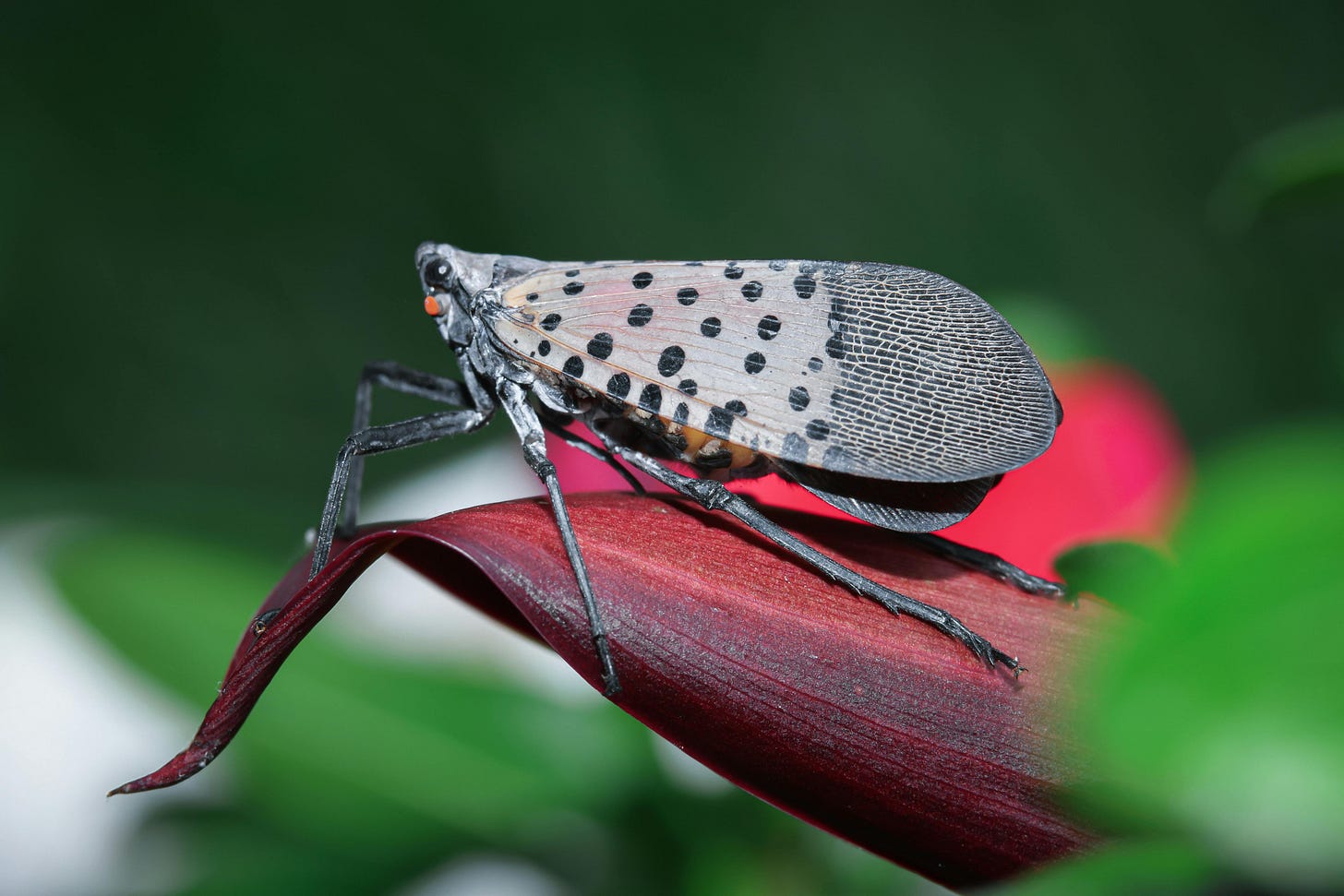The Great Lanternfly War (Spoiler: We Lost)
Turns out, our squash campaign was no match for 43 billion bugs — or the laws of ecology.
Starting back in 2020, state and federal governments began asking us to rise up against a common enemy — not a foreign power, but a bug. A flashy, bumbling, sap-sucking bug. The spotted lanternfly.
We were told to squish. To stomp. To engage in close-quarters combat with a winged invader. No license required. No training necessary. Just find one, and kill it.
Rarely is civic action so satisfying. It made us feel like gritty resistance fighters in the war for biodiversity. Every squashed lanternfly a tiny medal of honor. Every splat a victory in the campaign to save our forests.
Government officials, academics and the media joined forces to let us know just how much was at stake. In Pennsylvania alone, researchers warned that lanternflies could destroy fruit production, harm the hardwood industry, and hamper tourism, costing the state over $500 million annually. New York estimated potential losses upwards of $13 million to its wine-grape industry within just a few years.
Children were enlisted. Apps with squishing leaderboards were launched. Entire cities mobilized like it was World War Flea.
Despite this massive effort, the lanternfly front continues to advance. Breeding colonies have now entrenched themselves in 18 states, and scientists predict they will invade California by 2033.
What gives? Was our national bug-crushing campaign sabotaged by a lanternfly double agent embedded deep within the USDA? Did the bugs crack our surveillance systems? Was there an underground network of lanternfly sympathizers, stockpiling egg masses in their attics?
Or—bear with me here—was the whole "if you see it, squash it" plan never actually capable of working in the first place?
Let’s Do the Math
How many lanternflies would civilians in battleground states have to kill in order to turn the tide of this war?
There’s no official estimate of lanternflies in the United States, but there’s been a massive amount of research on the bugs. Mathematicians gathered it all together and estimated that these buggers roughly quintuple (λ=5.47) every year. So, if we started with two in 2011, we now have about 43 billion. [ Population=2×(5.47)14 ]
(Even though lanternflies were first officially spotted in 2014, agriculture experts believe they arrived in 2012, as eggs attached to landscaping stones that had been shipped from China, and were therefore laid in 2011.)
Now let’s just divide that by the population of the 18 states where it’s been found, which is about 148,000,000.
That means, every man, woman and child must squish about 290 lanternflies this summer. Totally do-able, right?
Sadly, no. Given the lanternfly’s impressive fecundity, you have to kill 35% of the bugs at each life stage to get the population trending downward. Since the bugs are not distributed evenly, that’s a lot of New Yorkers bug-stomping and egg-scraping in rural Pennsylvania. (We’d each be responsible for about 3 acres.) Adding to the difficulty: About 95% of lanternfly eggs are deposited higher than 6 meters (20 feet). So, be sure to pack a ladder.
The bad news? Lanternflies are here to stay.
The good news? They aren’t so bad after all.
Invasives Eating Invasives
The stated motivation for most lanternfly squishers is the environment. We are trying to protect America’s forests from a phloem-thirsty plant vampire. However, we’ve known since 2023 that lanternflies do not kill our native hardwoods. As it turns out, the poor little guys are practically starving in our woods. They are only able to complete their life cycle thanks to Trees of Heaven, a fellow invasive — which are, incidentally, the main casualty of the lanternfly invasion.
The only other notable casualty are wine grapes. Anecdotally, lanternflies appear to be reducing yields by around 10%. Happily, these are large bugs that can easily be controlled through exclusion netting. Unfortunately, some vintners report they’ve tripled their pesticide use to combat the bugs.
You may have heard that ravenous lanternflies have no natural predators in the USA, but it turns out that many kinds of insects and birds love eating the buggers. The lanternflies are also being killed off by 15 different fungal pathogens. All told, they appear to have integrated smoothly into our native ecosystems, with populations now rising and falling in the same boom-and-bust cycles typical of native insects.
You may not like lanternflies — they do have a nasty habit of pooping all over your patio furniture — but we can’t keep pretending that we’re killing them for environmental reasons. Humans fighting the bugs with pesticides, sticky traps and flame throwers are almost certainly doing more damage to the environment than the lanternflies themselves.
Grape News
We really overreacted to the lanternfly situation. Remember that 2019 report, the one that estimated the bugs would drain Pennsylvania’s economy of upwards of $500 million? That included damage to all sorts of things that lanternflies have turned out not to appreciably harm, including the timber industry, orchards, hospitals(?) and restaurants.
What has been affected, however, are vineyards. Let’s be generous and pretend that Pennsylvania’s wineries lost the full $8 million, the worst-case scenario predicted by the report. Even in this very unlikely scenario, the study that fueled America’s first squish campaign overestimated the lanternfly’s damage by at least $492 million.
Bugging Out
Why did the spotted lanternfly spark such a wild overreaction? Maybe we were just bracing for another disaster — after all, the emerald ash borer turned out to be far more devastating than anyone predicted. But we weren’t exactly flying blind: South Korea saw the lanternfly arrive years before we did, and while it annoyed city-dwellers and dinged some vineyards, it didn’t trigger ecological collapse. Indeed, the lanterfly population crashed a few years into the Korean invasion, which is also turning out to be the case here. Our worst-case fears weren’t inevitable — just loud.
And let’s be honest: it's a bit rich for us, the planet’s reigning invasive species, to declare total war on a much milder threat. It's like Godzilla starting up a neighborhood watch.
But maybe the deeper reason we freaked out is psychological. Lanternfly hysteria took flight around the same time as COVID lockdowns. Faced with a chaotic, invisible threat we couldn’t control, squashing something — anything — felt satisfying. Every smushed bug gave us a tiny hit of (illusory) agency.
If the lanternfly teaches us anything, it’s humility. We’re not landlords of the planet, we’re fellow tenants. Instead of raising kids to stomp every intruder, maybe we teach them gentleness, awe, and reverence for forces far bigger than us.
We are powerless against the lanternfly’s North American takeover, just as we’ll be powerless against other, more destructive forces we’ve already set in motion. The relentless march of this little leafhopper is a reminder: nature is in charge. And if we don’t tread lightly, she might be the one doing the squashing next time.







